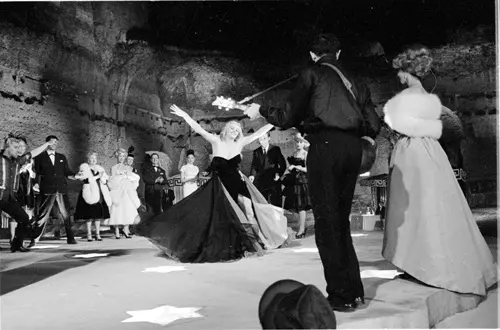
We use cookies
We use cookies and other tracking technologies to improve your browsing experience on our website, to show you personalized content and targeted ads, to analyze our website traffic, and to understand where our visitors are coming from.

Rome, Parco degli Acquedotti: a helicopter flies over the Claudian Aqueduct carrying, suspended beneath it, a statue of Christ destined for St. Peter’s. This is the memorable opening scene of La Dolce Vita. Marcello, an unscrupulous tabloid reporter – a “paparazzo” – lives at night in the streets of fashionable Rome, amidst stars, nobles and the wealthy, always surrounded by the flashing cameras of the photographers. The heart of the city’s nightlife is Via Veneto and its locations, a total of 80 sets, were recreated in Cinecittà for many of those scenes. One night, Marcello offers to keep a bored woman company, she stops her flashy car in Piazza del Popolo, picks up a prostitute and takes her home to her house in the suburbs (the exteriors are in Tor de’ Schiavi, in the Centocelle neighbourhood).
The Rationalist architecture of the EUR neighbourhood is featured more than once during the film: Marcello accompanies his girlfriend Emma to hospital here (the exterior is in Viale della Letteratura, the building is the Palazzo dei Congressi). This area is also the setting for the home of the writer Steiner as seen from his balcony view which features the unmistakeable outline of the building known as the “Mushroom”.
Although the facade of the Basilica where Marcello goes to see his writer friend appears to be set in EUR, it is actually the exterior of San Giovanni Bosco, in Viale del Salesiani, in the Tuscolano neighbourhood, while the interiors are those of the Church dei Santi Martiri Canadesi, in viale Giovanni Battista De Rossi, in the Nomentano area. This was the setting for the scene where Steiner plays Bach’s Toccata and Fugue in D Minor on the organ.
During the film, Marcello is assigned to follow Sylvia, a famous, exuberant film star. He finds out more about her when he takes her up the narrow staircase leading to the top of the Cupola of St. Peter’s (rebuilt in Cinecittà Studios), along with other reporters and photographers, and then at a nightclub set in the Baths of Caracalla, where she dances frenetically. Later they tour the historical centre of Rome where Sylvia admires the Trevi Fountain and walks into its water, taking Marcello with her: they kiss, in one of the most memorable scenes that cinema can remember.
The high society party where Marcello is taken by a friend is held in Palazzo Giustiniani-Odescalchi in Bassano Romano (VT). The famous last scene was shot on the beach of Passo Scuro, in Fregene on the coast outside Rome (Passo Scuro is also the setting for the trattoria where Marcello meets Paola). Although inspired by a house in Bagni di Tivoli, the villa used for the orgy scene was entirely rebuilt.
Rome, Parco degli Acquedotti: a helicopter flies over the Claudian Aqueduct carrying, suspended beneath it, a statue of Christ destined for St. Peter’s. This is the memorable opening scene of La Dolce Vita. Marcello, an unscrupulous tabloid reporter – a “paparazzo” – lives at night in the streets of fashionable Rome, amidst stars, nobles and the wealthy, always surrounded by the flashing cameras of the photographers. The heart of the city’s nightlife is Via Veneto and its locations, a total of 80 sets, were recreated in Cinecittà for many of those scenes. One night, Marcello offers to keep a bored woman company, she stops her flashy car in Piazza del Popolo, picks up a prostitute and takes her home to her house in the suburbs (the exteriors are in Tor de’ Schiavi, in the Centocelle neighbourhood).
The Rationalist architecture of the EUR neighbourhood is featured more than once during the film: Marcello accompanies his girlfriend Emma to hospital here (the exterior is in Viale della Letteratura, the building is the Palazzo dei Congressi). This area is also the setting for the home of the writer Steiner as seen from his balcony view which features the unmistakeable outline of the building known as the “Mushroom”.
Although the facade of the Basilica where Marcello goes to see his writer friend appears to be set in EUR, it is actually the exterior of San Giovanni Bosco, in Viale del Salesiani, in the Tuscolano neighbourhood, while the interiors are those of the Church dei Santi Martiri Canadesi, in viale Giovanni Battista De Rossi, in the Nomentano area. This was the setting for the scene where Steiner plays Bach’s Toccata and Fugue in D Minor on the organ.
During the film, Marcello is assigned to follow Sylvia, a famous, exuberant film star. He finds out more about her when he takes her up the narrow staircase leading to the top of the Cupola of St. Peter’s (rebuilt in Cinecittà Studios), along with other reporters and photographers, and then at a nightclub set in the Baths of Caracalla, where she dances frenetically. Later they tour the historical centre of Rome where Sylvia admires the Trevi Fountain and walks into its water, taking Marcello with her: they kiss, in one of the most memorable scenes that cinema can remember.
The high society party where Marcello is taken by a friend is held in Palazzo Giustiniani-Odescalchi in Bassano Romano (VT). The famous last scene was shot on the beach of Passo Scuro, in Fregene on the coast outside Rome (Passo Scuro is also the setting for the trattoria where Marcello meets Paola). Although inspired by a house in Bagni di Tivoli, the villa used for the orgy scene was entirely rebuilt.

Riama Film, Pathé Consortium Cinéma
Rome in the early 1960s, the parties, the excesses and the nightlife, seen through the eyes of Marcello, an unscrupulous tabloid reporter and aspiring writer, who inevitably ends up becoming part of it himself.